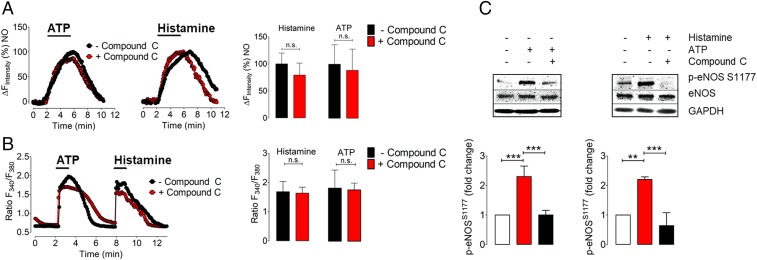Fig. 6.
Differential effects of Compound C on eNOS S1177 phosphorylation and NO formation. (A, Left and Middle) Representative time courses of NO signals in EA.hy.926 cells expressing the cytosolic orange variant of geNOps (O-geNOps) in response to 30 µM ATP (Left) and 10 µM histamine (Middle). Black curves represent control experiments while red curves represent NO responses of cells pretreated with Compound C (20 µM) before the experiment. (Right) Quantitative analysis of NO responses pretreated with Compound C (red bar, n = 3/11 for histamine, and n = 3/10 for ATP) and control conditions without any treatment (black bar, n = 3/10 for histamine, and n = 3/9 for ATP) (B, Left) Representative time course of cytosolic Ca2+ signals in response to ATP (30 µM) and, subsequently, histamine (10 µM) pretreated with Compound C for 20 min prior to the experiment (red curve) and without any pretreatment (black curve). Bars at Right represent the statistical analysis of the experiment shown in Left. Red bars represent cells pretreated with Compound C, n = 3/35 for ATP and histamine. Black bars represent control conditions, n = 3/34 for ATP, and histamine. n.s. indicates no statistical significance, unpaired t test. (C) Representative immunoblots are probing the consequences of AMPK inhibition on eNOSSer1177 phosphorylation responses. EA.hy926 endothelial cells were incubated with the AMPK inhibitor, Compound C (20 µM) for 30 min before the stimulation with ATP (30 µM) or histamine (10 µM) for 8 min. Cell lysates were analyzed in immunoblots probed with the phosphospecific antibody directed against phosphorylation site of eNOS at Ser1177. Equal loading was confirmed by immunoblotting with an antibody directed against total eNOS. Shown are pooled results analyzing the intensities corresponding to phospho-eNOS at Ser1177 by chemiluminescence from the independent experiments performed in triplicate. Values are presented as mean ± SD, **P < 0.01, ***P < 0.001 versus either control or Compound C-pretreated groups using ANOVA and Tukey’s multiple comparison test.

